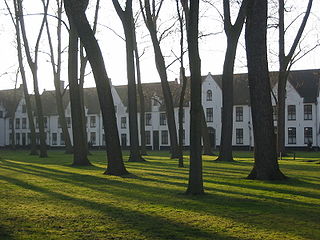
Nieuwenbosch Abbey, also Nieuwenbos Abbey (Dutch : Abdij Nieuwenbosch or Nieuwenbos) was a Cistercian nunnery in Heusden, East Flanders, Belgium, later relocated to Ghent.

Nieuwenbosch Abbey, also Nieuwenbos Abbey (Dutch : Abdij Nieuwenbosch or Nieuwenbos) was a Cistercian nunnery in Heusden, East Flanders, Belgium, later relocated to Ghent.
The Cistercian community was established in 1215 as the abbey of Onze Lieve Vrouwe ten Bosse at Bosse in Lokeren, known from 1259 as Oudenbos or Oudenbosch. The site was unsuitable because of the poor water supply and the nuns moved to the site in Heusden in 1257, when the name became "Nieuwenbosch".
The abbey was stormed and largely ruined in 1579 by the Iconoclasts, and the nuns moved for greater security inside the city of Ghent and built new premises in what is now the Lange Violettenstraat, in part using stone taken from the ruined buildings at Heusden, where the land and the few remaining structures were in due course rented out to farmers. The community was dissolved in 1796 in the French Revolution.
The only visible remaining structure on the Heusden site is the former abbey farm, now known as the Bosseveerhoeve (or hoeve Ten Bossche or hoeve Caenepeel). [1]

In 1948, on the site of the former abbey church (now the garden of the state horticultural college) was discovered a monumental effigy of Hugo II, castellan of Ghent (d. c. 1232), lord of Heusden and father of Hugo III, the most prominent benefactor at the time of the foundation of Nieuwenbosch. [2] The effigy is now in the Ghent City Museum.

Heusden was a municipality located in the Belgian province of East Flanders. In 1977 it merged with the municipality of Destelbergen, of which it is now part.

The Belfry of Ghent is one of three medieval towers that overlook the old city centre of Ghent, Belgium; the other two belonging to Saint Bavo Cathedral and Saint Nicholas' Church. Its height of 91 metres (299 ft) makes it the tallest belfry in Belgium. The belfry of Ghent, together with its attached buildings, belongs to the set of Belfries of Belgium and France, a UNESCO World Heritage Site.

Saint Michael's Church is a Roman Catholic church in Ghent, Belgium, built in a late Gothic style. It is known for its rich interior decoration.

Herkenrode Abbey was a Catholic monastery of Cistercian nuns located in Kuringen, part of the municipality of Hasselt, which lies in the province of Limburg, Belgium.

Saint Bavo's Cathedral, also known as Sint-Baafs Cathedral, is a Roman Catholic cathedral in Ghent, Belgium. The 89-metre-tall (292 ft) Gothic building is the seat of the Diocese of Ghent and is named for Saint Bavo of Ghent. It contains the well-known Ghent Altarpiece, also called the Adoration of the Mystic Lamb.

Sint-Barbaracollege in Ghent, Belgium, is a public Jesuit school, founded in 1833. It currently includes primary and secondary education.

The Princely Beguinage Ten Wijngaerde is the only preserved beguinage in Bruges, Belgium. There are no more beguines living there, but since 1927, it has functioned as a convent for Benedictines, founded by canon Hoornaert. In the same year, the houses at the west side were also reshaped and enlarged into the Monasterium De Wijngaard, a priory of Benedictine nuns.

Male Castle, Bruges. A community of the Canonesses Regular of the Holy Sepulchre. It originated in Bruges in the 11th century, and between 1954 and 2013 was settled in Male Castle in Male, Sint-Kruis, Bruges, West Flanders, Belgium.
The Abbey of Onze-Lieve-Vrouw ter Nieuwe Plant, formerly also Roesbrugge Abbey is a community of Augustinian canonesses belonging to the Congregation of Windesheim. The sisters are informally known as the Roesbrugge Dames - the Roesbrugge Ladies. Located in Roesbrugge from 1239 to the late 16th century, the community then moved into Ypres, West Flanders, Belgium, where it exists today. Its adjacent school is the Lyceum Onze Lieve Vrouw ter Nieuwe Plant.

Bethlehem Abbey in the village of Bonheiden, Belgium, is a house of Benedictine nuns of the Subiaco Cassinese Congregation. The monastery was built in 1965 as a Redemptorist house but was transferred to the Benedictines in 1975.

The Antwerp Jazz Club is an association in Antwerp, Belgium, founded in 1938 by Hans Philippi, which delivers weekly lectures about and presentations of jazz music, at no cost, open to the public at large. Its sessions are held in Dutch. Other than these sessions, the club organizes concerts, including helping to organize blues concerts; and has aided in the screenings of jazz documentaries.

Ten Duinen Abbey or the Abbey of the Dunes was a Cistercian monastery at Koksijde in what is now Belgium. It was one of the richest and most influential religious institutions in the medieval County of Flanders. It later relocated from Koksijde to the city of Bruges.

Oosteeklo is a historic village in the Flemish province of East Flanders, Belgium, which since 1977 has been a subdivision of the municipality of Assenede. The village is situated 9 km east of Eeklo and 17 km north of Ghent, about 9 km from the border with the Netherlands, and lies approximately 9 metres above sea-level.

Oosteeklo Abbey was a Cistercian nunnery founded in Oosteeklo in 1217 and later moved to Ghent.

Jan van Hembyse or Hembyze was a Flemish politician and popular leader, with a demagogic tendency, who together with François van Ryhove brought about the Calvinist Republic of Ghent and for two periods led that regime in the early stage of the Dutch Revolt and the Eighty Years' War as it unfolded in the County of Flanders.

Ninove Abbey was a monastery of the Premonstratensian Order in the center of Ninove, in the province of East Flanders, Belgium. Only the abbey church now remains.

Ocket Castle is a house, on the site of a castle, in Heusden, Destelbergen, East Flanders, Belgium. It probably originated on the former fief of Grooten Hoek that lasted until the 15th century. The castle was depicted on a 1725 map by PJ Benthuys as a building with a moat near the Scheldt and is mentioned in 1767 as a "partije genaemt den grieten hoeck met de mote ende huys van playsance". The present Neoclassical building dates largely from the 18th and 19th centuries but contains a dining room on the east side that in the 17th/18th century was the core of the structure, as was established among other things from the beams and the Rococo stucco decorations.

St Anthony of Padua Church or Rainbow Church is a Catholic church in Ghent, Belgium. It was constructed in Gothic Revival style in the years 1898–1900 to a design by architect Hendrik Geirnaert, as the parish church for the expanding 'Heirnis' section of the city. The new parish was established on 14 May 1896, but the Liberal majority on the local council initially opposed the building of a new church. The church was consecrated on 25 July 1901, by bishop Antoon Stillemans. The organ was built by Brussels organ maker Pierre Scheyven. It has been inventoried as built heritage since 1983.